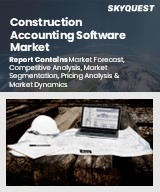
건설 회계 소프트웨어 세계 시장 규모는 2023년에 25억 달러로 평가되었고, 2024년 26억 7,000만 달러에서 2032년에는 45억 6,000만 달러에 이르고, 예측 기간(2025-2032년) CAGR은 6.9%를 보일 전망입니다.
세계 건설 회계 소프트웨어 시장은 실시간 비용 추적, 정확한 예산 관리, 컴플라이언스 준수 보고에 대한 수요 증가에 힘입어 강력한 성장세를 보이고 있습니다. 계약업체, 건설업체, 개발업체들은 작업 원가 계산, 급여 관리, 세금 규정 준수를 강화하는 클라우드 기반 재무 도구에 주목하고 있습니다. 업무를 자동화하고, 인적 오류를 최소화하며, 재무 프로세스를 중앙 집중화하는 소프트웨어의 기능은 특히 중소규모의 건설회사에 큰 변화를 가져오고 있습니다. 이러한 기업들이 보다 명확한 운영을 요구함에 따라 건설 회계 소프트웨어의 중요성은 계속 증가하고 있으며, 업계에서 필수적인 리소스로 자리매김하고 있습니다. 이러한 추세는 건설 업계의 재무관리 최적화에 있어 건설회계 소프트웨어가 국제적으로 매우 중요한 역할을 하고 있음을 보여줍니다.
Global Construction Accounting Software Market size was valued at USD 2.5 billion in 2023 and is poised to grow from USD 2.67 billion in 2024 to USD 4.56 billion by 2032, growing at a CAGR of 6.9% during the forecast period (2025-2032).
The global construction accounting software market is witnessing robust growth fueled by an increasing demand for real-time cost tracking, precise budgeting, and compliant reporting. Contractors, builders, and developers are gravitating towards cloud-based financial tools that enhance job costing, payroll management, and tax compliance. The software's ability to automate operations, minimize human error, and unify financial processes has been transformative, particularly for small and mid-sized construction firms. As these companies seek greater operational clarity, the significance of construction accounting software continues to rise, positioning it as an essential resource in the industry. This trend underscores the software's pivotal role in optimizing financial management within the construction sector on an international scale.
Top-down and bottom-up approaches were used to estimate and validate the size of the Global Construction Accounting Software market and to estimate the size of various other dependent submarkets. The research methodology used to estimate the market size includes the following details: The key players in the market were identified through secondary research, and their market shares in the respective regions were determined through primary and secondary research. This entire procedure includes the study of the annual and financial reports of the top market players and extensive interviews for key insights from industry leaders such as CEOs, VPs, directors, and marketing executives. All percentage shares split, and breakdowns were determined using secondary sources and verified through Primary sources. All possible parameters that affect the markets covered in this research study have been accounted for, viewed in extensive detail, verified through primary research, and analyzed to get the final quantitative and qualitative data.
Global Construction Accounting Software Market Segments Analysis
Global Construction Accounting Software Market is segmented by Deployment, Organization Size, Industry, Functionality, Price Range and region. Based on Deployment, the market is segmented into Cloud-based and On-premises. Based on Organization Size, the market is segmented into Small & Medium Businesses and Large Enterprises. Based on Industry, the market is segmented into Residential Construction, Commercial Construction, Civil Infrastructure, Industrial Construction and Specialty Construction. Based on Functionality, the market is segmented into Billing & Invoicing, Payroll & HR, Job Costing, Equipment Tracking and Project Management. Based on Price Range, the market is segmented into Low, Mid and High. Based on region, the market is segmented into North America, Europe, Asia Pacific, Latin America and Middle East & Africa.
Driver of the Global Construction Accounting Software Market
The increasing complexity of construction projects, coupled with the geographical dispersion of teams and the need for meticulous budget management, has made real-time financial tracking a vital requirement. Contractors, developers, and project managers are increasingly turning to specialized accounting software to gain greater insight into cost overruns, material acquisitions, subcontractor payments, and cash flows, surpassing the limitations of traditional manual accounting methods. Such software enhances flexibility in budget forecasting, allows for the early detection of discrepancies, and facilitates rapid responses to change orders. This shift underscores the demand for efficient financial management tools in the evolving construction landscape.
Restraints in the Global Construction Accounting Software Market
One significant challenge facing the global construction accounting software market is the lack of digital skills and awareness among smaller and independent contractors. Many of these smaller firms depend on basic spreadsheets or general accounting systems that do not cater to the unique financial needs of project-based work. With constrained budgets, these contractors hesitate to invest in new technologies or training due to fears of disrupting their established processes, especially when they have achieved recent success using familiar tools. Furthermore, the plethora of software choices, pricing structures, and feature sets can be intimidating for those lacking the necessary expertise and experience to navigate them effectively.
Market Trends of the Global Construction Accounting Software Market
The Global Construction Accounting Software market is experiencing a significant trend toward the integration of accounting and project management platforms. This convergence reflects a growing demand for real-time collaboration between finance and operational teams, breaking down silos that traditionally separated these functions. As the software evolves, it increasingly amalgamates with project scheduling, procurement, field tracking, and safety compliance tools, allowing all project data to reside in a single system. Vendors offering unified solutions or fostering strategic alliances with third-party applications are gaining a competitive edge, catering to large construction firms' desire for enhanced transparency and streamlined decision-making processes across their operations.